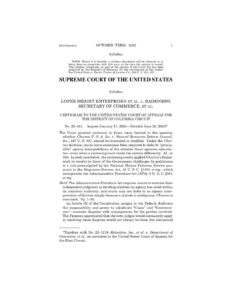By Eric Magleby
The US Supreme Court has overturned Chevron, ruling against a judicial doctrine that requires courts to defer to administrative agencies’ interpretations of ambiguous statutes. In so doing, the Court has changed a fundamental doctrine underscoring constitutional limits of agency rulemaking and has intellectual property (IP) owners and practitioners alike questioning what the ramifications may be.
Just days after Chevron became a 40-year-old precedent, the US Supreme Court delivered its opinion in Loper Bright Enterprises v. Raimondo (Loper), holding that Chevron deference is incompatible with the Administrative Procedures Act (APA) and principles governing the role of the judiciary. The controversy before the Court arose from a rule promulgated by the National Marine Fisheries Services (NMFS) pursuant to the Magnuson-Stevens Act, which authorizes the NMFS to require that federal observers be carried on fishing vessels to monitor compliance with regulations targeting overfishing. In exercising this statutory authority, the NMFS required the fishing industry to pay the salaries of these federal observers while they carry out their monitoring duties on-board. Because the Magnuson-Stevens Act does not address who should pay the salaries of the federal observers, a group of fishing companies argued that the NMFS’s salary payment requirement was an improper exercise of agency authority. More significantly, because the Magnuson-Stevens Act incorporates the APA, the Court had occasion to address a much more consequential question as to whether Chevron deference should be upheld in view of the APA.
In a 6-3 vote, the Court held that Chevron is inconsistent with the APA, which states that “reviewing court[s] shall decide all relevant questions of law, interpret constitutional and statutory provisions, and determine the meaning or applicability of the terms of an agency action.” 5 U.S.C. § 706. The Court thus held that Congress expressly delegated the responsibility to interpret statutory provisions to the judiciary, not agencies, via the APA. The Court reasoned that matters of statutory interpretation are always questions of law, and thus within the purview of courts, as supported by legal tradition establishing the interpretive role of the judiciary. The Court also determined that courts’ “full interpretive toolkit[s]” and reliance on evidence presented by parties and amici sufficiently enable courts to handle all questions of statutory interpretation, even if such interpretation involves technical matters, and that agencies’ special competencies do not help them resolve statutory ambiguities.
Justices Thomas and Gorsuch delivered concurring opinions, stating respectively that Chevron ran contrary to the principle of separation of powers by conferring upon the executive too much rule-making authority, and that overturning Chevron is supported by—not contrary to—stare decisis (the legal principle that previously decided cases establish precedent that should be followed in future cases).
Justice Kagan dissented, arguing that the majority’s decision amounts to the judiciary exercising power that Congress intended to delegate to agencies. In particular, she argued that Congress was aware of the special competence of agencies with respect to technical and regulatory matters, and thus ambiguities and gaps in statutory language reflect a presumed Congressional intent to delegate certain matters to the discretion of agencies. Chevron deference, she argued, represented the judiciary’s recognition of this presumption. Justice Kagan further argued that agencies do in fact have expertise for interpreting technical ambiguities that courts are unqualified to address (e.g., whether certain organic compounds are or are not a “protein” or what characteristics make one animal population “distinct” from another). The dissent also questioned whether the majority’s decision to overturn a 40-year precedent on which Congress relied when drafting statutes exposes the judiciary to political decision-making and violates stare decisis.
The US Supreme Court’s decision in Loper raises questions as to whether and how the elimination of Chevron deference will affect IP law. Chevron deference has been invoked by the Federal Circuit to defer to the United States Patent and Trademark Office (USPTO) with respect to various matters, including the standards for claim construction in inter partes review (IPR) proceedings, whether the USPTO director is permitted to delegate institution decisions to the Patent Trial and Appeal Board (PTAB), and whether the PTAB has discretion to limit the scope of institution in IPRs. More recently, a petition was filed requesting the US Supreme Court revisit whether the International Trade Commission (ITC) should have authority to ban importation of products that do not necessarily infringe a patent when they enter the U.S. if the manufacturer later induces infringement.


